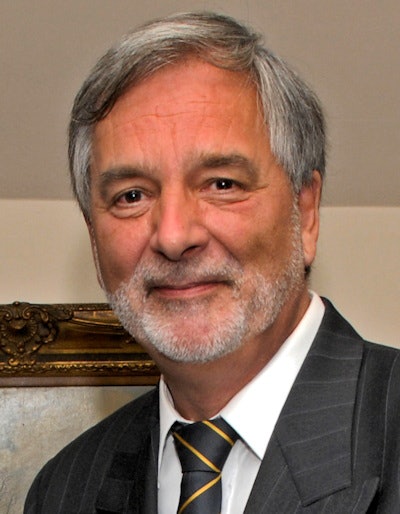
For some time now, new developments in MRI have been mostly apps and gadgets playing with the data acquired. Seldom is the actual usefulness of these appendages being validated.
 Dr. Peter Rinck, PhD.
Dr. Peter Rinck, PhD.Such outcome research is neither trendy nor attractive -- nor does it fill pockets with ready cash. It is more work to milk a cow and make cheese than to watch it being digested.
The development of MRI during the last five decades has been accompanied by paradigm shifts and changes in basic assumptions of what was regarded as conventional wisdom and predictable commercial reward. The new move to low- and medium-field equipment follows this rule.1
At present, the question for potential buyers of low-field MRI scanners is: Do I want the latest but apparently still immature technology or established and functioning equipment that is not so sexy?2
When one studies the recent scientific developments, one finds that the research branch of the Japanese company Hitachi recently presented an MRI machine that can be switched on and off rapidly so that it could be used in the operating room.
It is an open 1.1-m-diameter system based on a superconducting magnet made with company-produced high-temperature superconducting magnesium diboride (MgB2) wire. Its length is 5.6 kilometers. The vendor stated that it will proceed with the development of various superconducting magnets that use MgB2 wire and aim to be refrigerant-free and reduce power consumption.
To date, in most cases these wires can be very brittle and the connection of one wire to the next seems to be a major problem. The specialists in the field claim that the high stability of the magnetic field necessary to create high-quality MR images cannot be guaranteed and might deteriorate over time. From this point of view, the excitement at the prospect of novel wire technologies for superconductive nearly helium-free MRI equipment seems to be a little premature.3,4
With their technology, the Japanese are one step ahead of an Italian company that is already trying to market MgB2 superconducting magnets.
A detailed internal scientific memorandum pointed out some difficult steps not yet overcome in the development of a reliable long-term solution -- among them the best composition of the kilometers-long wires for the magnets' coils.
Apparently, the magnet is not operated in the persistent mode due to a lack of reliable superconducting joining technique of reacted MgB2 conductors. Therefore, the magnet is continuously charged using a precise power supply during imaging and has a relatively high power consumption, which is perhaps one of the reasons for the limited deployment of this MRI system in hospitals and private practices. Another setback is the weight of the system: 28 tons.
Users also complain that the sophisticated multiposition patient examination couch is difficult to clean and disinfect. However, a great advantage of this MRI system is the option that patients can be moved from a supine (lying down) position to a standing position, allowing imaging under the effects of gravity.
In this, the MgB2 manufacturer competes with a well-established company producing MRI equipment in the same Italian city. They also have a tilting weight-bearing MRI system permitting multiposition imaging, for instance for musculoskeletal applications. It has a proven conventional "old-fashioned" permanent magnet that doesn't suck much energy and doesn't need helium. Also, its weight is only 7.9 tons.
For decades the euphoria over new offspring techniques of MRI has been reliably followed by disillusionment. Exaggerations are, and were, widespread. There has been progress, but much of the trust of the people who actually count on the developers and researchers was lost. They were taken on a constant roller coaster ride into nowhere.
Many patients, politicians, and, to some extent, physicians believe that higher medical performance and novel medical equipment are a sign of higher quality in care. Very often new diagnostic technologies are claimed to be more cost-efficient and faster -- but then early adopters are annoyed by malfunctioning or badly thought-out equipment.
We do not know yet what the outcome in this case will be. It's another wait-and-see situation.
Dr. Peter Rinck, PhD, is a professor of radiology and magnetic resonance and has a doctorate in medical history. He is the president of the Council of the Round Table Foundation (TRTF) and the chairman of the board of the Pro Academia Prize.
The comments and observations expressed herein do not necessarily reflect the opinions of AuntMinnieEurope.com, nor should they be construed as an endorsement or admonishment of any particular vendor, analyst, industry consultant, or consulting group.
References
1. Rinck PA. Smashing the magnetic field strength dogma. MRI: an unexpected change. Rinckside 2021; 32,1: 1-3. http://www.rinckside.org/Columns/2021_02-Field_strength.htm
2. Rinck PA. New, improved radiology demands better analysis. Rinckside 2002; 13,3: 9-11. http://www.rinckside.org/Columns/2002%2010%20New%20improved%20radiology%20demands%20better%20analysis.htm
3. Patel D, Matsumoto H, Kumakura H, Maeda M, Kim S, Hossain SA, Choi S, Kim JH. MgB2 for MRI application: Dual sintering induced performance variation in in situ and IMD processed MgB2 conductors. J Mater Chem C (Royal Society of Chemistry). 2020, DOI: 10.1039/C9TC06114B.
4. Ballarino A, Flükiger R. Status of MgB2 wire and cable applications in Europe. J Phys: Conf Ser 2017. 871 012098



















